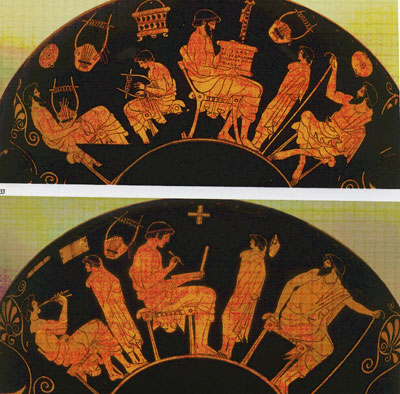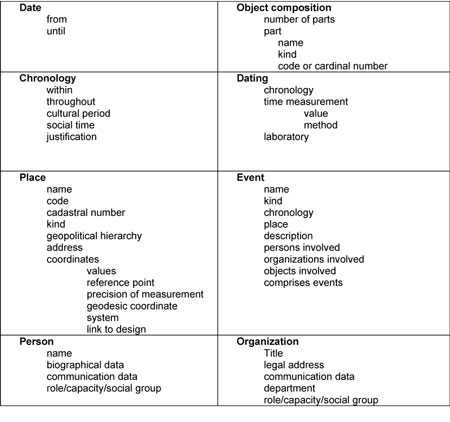
ERCIM News 66July 2006Special theme: European Digital Library Contents This issue in pdf Subscription Archive: Next issue: October 2006 Next Special theme: |

by Chryssoula Bekiari, Panos Constantopoulos and Martin Doerr
Digital cultural repositories emerge from the ever-increasing digitization of documents and images, digital photography, analogue-to-digital conversion of audio or video recordings, and digital transcription of object information recorded in various ways. Adding original digital cultural products and digital recordings of cultural information to these digital surrogates leads to an impressive collection of digital cultural material.
As digital collections are created independently by autonomous organizations, the emergence of a unified digital space is neither automatic nor easy. Aside from the legal and organizational issues, certain conditions are required for repositories to be interoperable. These are primarily concerned with documentation data and processes. Cultural documentation comprises a wide spectrum of information on the objects themselves, physical or informational, as well as related processes ranging from data acquisition to various scientific studies, conservation, exhibition design and publication. These processes may be separately documented and multiple relevant data sets may exist. If all this information is to be truly useful, we must ensure the ability exists to easily access and analyse information from disparate sources.
 |
| Instruction in ancient Athens, red-figured attic vase, 5th c. BC, Berlin Archaeological Museum. |
Interoperability has a syntactic and a semantic aspect. Syntactic interoperability is achieved by conforming to standards for information encoding and exchange. Semantic interoperability is the ability of different information systems to provide information consistent with the intended meaning. In practice, semantic interoperability aims to associate knowledge dispersed in various carriers and forms, thereby allowing related concepts to be automatically identified. To do this, standards for representing objects, functions and content must be adhered to, during both documentation and 'productive' uses of digital information.In order to build a framework for developing interoperable cultural digital repositories we follow a dual strategy. First, we draw on standard (meta)data structures recommended by established national and international bodies concerning archaeological, ethnological, museological, archival, geographical, terminological and digital preservation data for specific application areas. Second, all structures in the framework are related to a common ontology (namely CIDOC CRM of the International Council of Museums (also ISO Draft Standard 21127)) for long-term semantic interoperability, and are written in XML for syntactic interoperability. The CIDOC CRM is an ontology describing the concepts and relations involved in cultural documentation. It provides a common base for the interpretation of various forms of documentation, but does not dictate the documentation elements. Thus it plays a pivotal role in building interoperable digital cultural repositories.
 |
| Table 1: Examples of information patterns. |
On this basis we define a set of information patterns, ie fundamental types of information unit such as time, place, object composition, event etc. This reduces the problem of designing cultural object records to one of designing a set of information patterns and a general, flexible record structure. As there are fewer information patterns than record fields, the design and the conformance with relevant standards are much more closely controlled. Rather than independent records, we thus obtain a family of records, conformant at the information pattern level. This allows different needs to be addressed and systematic data-entry procedures to be adopted, and ensures interoperability. Examples of information patterns are given in Table 1. Furthermore, for the description of museum objects and site monuments we have produced a comprehensive, CIDOC CRM-compliant, common XML DTD, resulting in a new, dynamic cultural object record of unprecedented genericity. Supporting a pragmatic object documentation workflow model, this object record can accommodate everything from minimal to highly detailed object information in structured and unstructured forms, thus gracefully adapting to the needs of various working contexts.
The XML DTD is available as a ready-to-use CIDOC CRM-compliant solution, along with higher-level guidelines and the CIDOC CRM ontology itself. Further work includes a number of application-specific extensions and, most importantly, domain extensions arising from current advances in harmonizing the CIDOC CRM with the FRBR (the bibliographic record model endorsed by IFLA).
This work, carried out at the Centre for Cultural Informatics, FORTH-ICS, was part of the compilation of guidelines for cultural digitization projects under the Greek Information Society Programme. It draws heavily on previous and concurrent experiences from several cultural information modelling and integration projects. It also benefits from the development of the CIDOC CRM ontology and the activities within the DELOS Network of Excellence on Digital Libraries, which are devoted to the harmonization of the CIDOC CRM and ABC (DELOS 1) and the CIDOC CRM and FRBR (DELOS 2) models.
Please contact:
Chryssoula Bekiari, ICS-FORTH, Greece
Tel: +30 2810 391631
E-mail: bekiari![]() ics.forth.gr
ics.forth.gr